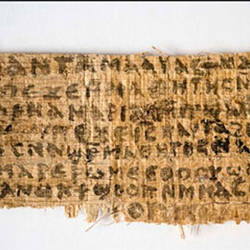Professor Discovers Reference to Jesus’ “wife” on Ancient Papyrus
Vatican Insider
A piece of papyrus written in Sahidic, a Coptic dialect of Lower Egypt, has rekindled the Jesus marriage debate. Professor Karen King of Harvard Divinity School presented the scrap of papyrus at a conference in Rome. It reads: “Jesus said to them, 'My wife ....'”.This is the first and only explicit reference to Jesus having a wife, the New York Times reported. In her study, which will be published in the Harvard Theological Review in January 2013, Professor King warned that this finding does not constitute definitive proof of Jesus having been married, although everything indicates that the fragment is genuine: various experts have excluded the possibility of the text having been added later on, to an ancient piece of papyrus. The fragment is small, it only measures 4 by 8 centimetres and only bits of longer sentences are legible. Professor King stated: "It is not evidence, for us, historically, that Jesus had a wife," but it highlights that the question of his possible marriage and his sexuality were often the subject of intense debate. The writing on the papyrus suggests the text was written in the second half of the 4th century. But its contents could have been copied form a 2nd-century Greek text. There could be a link with between this text and other texts of the time, known as the Gospels of Thomas and Mary – texts which were born out of a Gnostic context. As is known, the Church only recognises the “canonical” Gospels of Evangelists Matthew, Mark, Luke and John as authentic texts. These date back to the 1st century: Matthew and John were apostles while Mark and Luke were followers of Peter and Paul. Although the common belief is that ecclesiastical authorities imposed the canonical gospels over other texts which were rejected as “apocryphal”, this is not quite true. The canonical gospels were the most widespread among Christian communities, which recognised the apostolic origin of these texts and thus their link with eye witnesses of Jesus’ life. So the canonical gospels were canonical well before they were actually defined as such. A fragment discovered in the Vatican Library by Ludovico Muratori proves that these gospels were being read and venerated as far back as the year 157. The term “apocryphal”, which is used to refer to gospels that were not recognised by the Church, is a Greek word meaning “hidden”: in the 2nd century there were some written texts being which were particularly popular among Christian Gnostic circles and were defined as “apocryphal”. These are later texts, which would used to try to reconstruct some parts of Jesus’ life or to interpret his thinking. In general, the canonical texts are sober, only contain essential information and do not indulge in miraculism, the apocryphal texts are full of miraculistic and sensationalist elements. In some cases these are expressions of the philosophical-religious Gnostic movement which believed in a radical dualism, in an abyssal difference between God and material reality. Italy’s top expert on these texts, Luigi Moraldi wrote: “The Gnostic Gospels are reflections on Jesus, on his message, on the reactions he triggers in each believer, particularly in intellectuals… they are not collections of biographical facts about Jesus. They expect the reader to have a detailed knowledge of the Christian message, both of the early and later stages of its development.” The fragment referred to in this article is of Coptic origin as were other Gnostic texts. Why does the Church claim Jesus never married? The canonical gospels present Jesus as celibate. Despite the fact that he often referred to female characters in his preaching and parables and even though there was a group of women who were constantly by his side, none of the women mentioned in the canonical gospels are presented as his wife. However, the authors of the canonical gospels do not describe celibacy as a more superior state in comparison to marriage. Peter was married (the Gospel mentions his mother-in-law being healed), as were some of his earliest disciples. Many influential Biblicists say that is Jesus had ever been married, the evangelists would have written about it. Objections to Jesus’ celibacy often stem from the fact that religious teachers in the Jewish world tended to marry. But even two thousand years ago, exceptions to the marriage rule were not that rare, as is proven by the Essene community. This community lived in the Qumran and all its members were celibate.
|
.
Any original material on these pages is copyright © BishopAccountability.org 2004. Reproduce freely with attribution.
